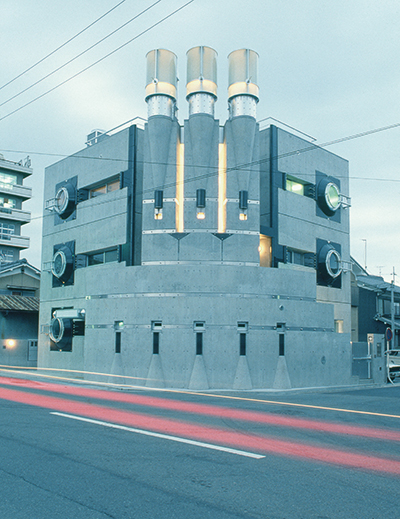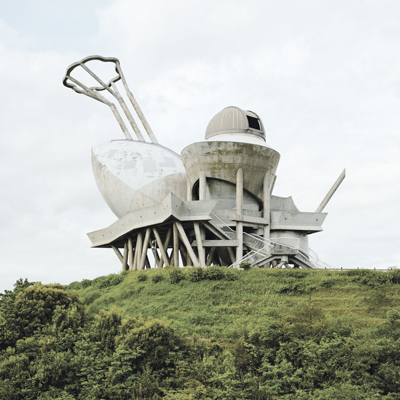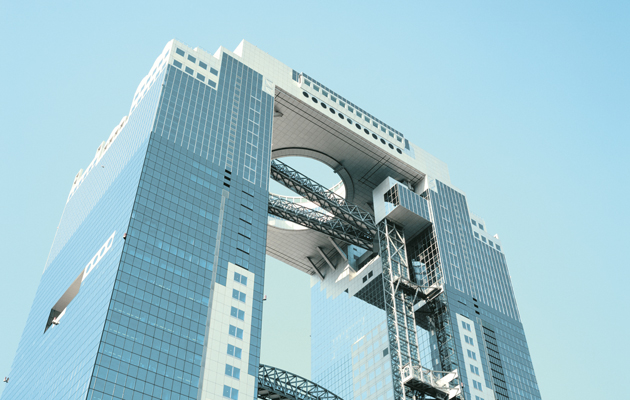|
Japan’s 1980s boom was marked by unhinged wealth and intense architectural creativity. Its legacy includes some of the most wildly original buildings the world has ever seen, writes Adam Nathaniel Furman Japan in the 1980s was a nation hurtling at exponentially increasing speeds into a seething, self-consuming, technologically fantastical, aesthetically ravishing future, fuelled by a turbo-charged mixture of industrial innovation, financial speculation and the biggest real-estate bubble the world had ever seen. An unprecedented wave of development transformed the nation’s cities, feeding off insane land valuations that saw property selling in Ginza for $750,000 per square metre. The land on which the Imperial Palace sat in Tokyo was calculated to be worth more than all the real estate in California combined. Read more: Kengo Kuma on the need for intimate space in cities While Japanese corporations were hoovering up companies around the world, small rural towns with more money than they knew what to do with were building gigantic museums, stadiums and bridges, and a riotous sense of raging hyper-reality was manifesting itself across Japanese culture. The financial explosion ignited a chain reaction of artistic subcultures and forms of expression – from the dystopian future Tokyos of Ghost in the Shell and Akira, to Hayao Miyazaki’s anime films with their collapsing together of past and present, fantastical and banal, and Western and Japanese, to the urban condition of the country’s great cities, which were rapidly coming to resemble the hyper-saturated vision of Ridley Scott’s Blade Runner.
Pharoah Dental Clinic in Kyoto by Shin Takamatsu – a furious clash of technology, history and oral hygiene
The efflorescence of strange new forms was particularly marked in architecture, in which a generation of designers produced some of the most distinctive buildings to be found anywhere in the world. Unlike other countries, where development is usually at a very large scale, the vast majority of construction in Japan occurs towards the smaller end of the spectrum. Even in times of normal economic activity this allows for younger, and more alternative architects to acquire commissions. But in the boom years it led to a feverish bonanza of commissions for a host of architects with highly idiosyncratic approaches. Buildings by a few of the (unfathomably) more forgotten of these designers are shown here. Hiroyuki Wakabayashi, a Kyoto architect from a product design background, produced the Life Inn in Kyoto in 1986, a mountainous building of stacked cubes inside which is carved a fragmented, feverishly ornamental void replete with its own grotto waterfall and exploding, colourful geometries, reminiscent of the most eccentric science-fiction film sets. Through his following projects, the complexity and hyper-ornamentation of that interior void came to conquer the entirety of his compositions. The Unagidani Children’s Museum in Osaka is an eroded, pre-ruined, eight-storey concrete frame in which every 3m grid space contains an entirely distinct little building, each formed from an entirely distinct, highly crafted, but clearly Wakabayashi-generated architectural style. His Humax pavilion in Tokyo captures the simultaneous impulse to be technologically fantastical and moodily historical, while encrusting the entire form of the building, inside and out, in a cacophony of brooding ornament. As he put it: ‘It is an irrational instinct for man to long for the future while latently having a desire to refer back to the past; this architecture is the best embodiment of this instinct.’ The building looms with theatrical menace over Shibuya, like a gigantic, ancient, futuristic artefact. |
Words Adam Nathaniel Furman
Main image Kengo Kuma’s M2 Building in Tokyo – originally a car showroom, it is now a funeral parlour
Image credits: Courtesy Shin Takamatsu architect and associates Co., Ltd; |
|
|
||
|
Takefumi Aida’s Toy Block House III – playful or slightly sinister? |
||
|
Wakabayashi does not need scale for effect – his tiny Maruto 15 and 17 buildings in Kyoto are equally intoxicating in their alien eeriness, and are perfect examples of his total impregnation of form with evocative ornament, absorbing all of one’s attention when walking along the streets on which they sit. The most internally coherent and intriguing body of work from the period was produced by another Kyoto-based architect, Shin Takamatsu, whose obsessively composed and detailed buildings are best known in the West from the Piranesian, chiaroscuro drawings he produced to illustrate them. The drawings do give a strong impression of his rather dark vision of architectural space, but it is only through visiting his buildings that one can fully absorb their extraordinary richness. His works are psychological journeys made through the act of architecture. He fuses an exceptional range of references, together with newly invented motifs, into designs that rival the most iconographically elaborate of Europe’s fin-de-siècle architecture, only here they create a language of overloaded technology crashing together with subjective poetics, personal angst and history. It is a fusion that only late 20th-century Japan could have produced.
Takamatsu’s Syntax retail centre, also in Kyoto but now demolished Two of Takamatsu’s Kyoto projects, the Pharaoh Dental Clinic (1984) and Syntax retail building (1988–90, now demolished), express these qualities perfectly. Both relatively small in scale – with Pharaoh being positively minute – they are powerfully expressive forms, verging on being frighteningly so in their intensity. The fierce effect his buildings elicit in visitors was always carefully calibrated by Takamatsu, who has often described the thrilling tensions which pulse in his structures, and which draw passers-by towards them with wary interest. Of Syntax, he said that it was a ‘space that is menacing, the parts menacing the whole, the whole menacing the parts, and even the parts menacing each other, just as the whole menaces itself’. Takamatsu produced an astonishing body of work, and much like his Kyoto counterpart Tadao Ando, the precision and consistency, while constantly inventing and inquiring, is astonishing. At the other end of the country, on the northern island of Hokkaido, Kiko Mozuna built an entire oeuvre, mostly around the municipality of Kushiro, based on his own esoteric cosmic principles. Each of his buildings, and his architectural-philosophical ideas about the nature of architecture, were explored through exquisitely complex, colourful and layered drawings, so intricate that they often approach the visual potency of mandalas. The blending of influences explored through these drawings is clearly visible in projects such as the Kushiro Municipal Museum (1984), with its strange recollection of ziggurats, mounds and symbolic Japanese forms, as well as the pre-ruined Nusamai Junior High School (1986), the hyperactive, symbolic overload of Kushiro Fisherman’s Wharf (1989) and the stacked, scaled architectures of his Kushiro Castle Hotel (1987). In Tokyo, Kengo Kuma produced the bizarre M2 building (1991), a sublimely surreal nightmare of architectural-historical forms blown out of scale and crashed together in aggressive, purposeful abandon. Originally a car showroom for Mitsubishi, it has since been repurposed as a funeral parlour – a supremely appropriate programme for this uncanny intervention into the Tokyo cityscape. Toyokazu Watanabe’s monumental concrete or steel-grey buildings seem to come straight out of a film by Studio Ghibli, blending Japanese and Western references with an eye for a kind of fantasy picturesque. His relationship to references evolved from his Standard House 001 in Nakano (1979), which took Adolf Loos’s unbuilt tomb for Max Dvorak, built its general form, but transformed it through the application of a different materiality (his trademark grey) and numerous domestic apertures, leaving it hovering somewhere between Japanese suburbia and fin-de-siècle Vienna. Kihoku Observatory by Takasaki Masaharu – ‘One almost expects its columns to start rising up and down’ This transformation of precedents rapidly became more complex with his Okamuro House of 1981, merging a suburban house with an observatory and a coffered dome, in a combination that Charles Jencks has described as ‘hallucinatory’. By the time he was building large-scale works such as the Bunka No Sato Cultural Centre on Tsushima Island (1990), the awesome Akita City Gymnasium (1991), the Kamo Culture Centre (1994) and the Kamiyubetsu Folk Museum (1996), each of his projects had become a veritable carnival of incorporated references, blended into fantasy worlds specifically crafted for his built endeavours. Between 1979 and 1984, Takefumi Aida created a series of houses in Tokyo based on toy blocks. With the intention of rediscovering a sense of playfulness in the act of design and in the associations conjured up by a building, he created structures that in fact come across as rather sinister in the outsize scaling of familiar elements. In their piling-up and profusion, the implied toy blocks start to recall the partially ruined and re-appropriated symbolic ceremonial structures of lost civilisations, as if a monstrously large and melancholic child was attempting to reconstruct Mycenea or Machu Picchu. Aida said that ‘the extent to which a building can be the manifestation of an architect’s sensibility determines the importance of architecture in a given culture’. As is evidenced by his houses and other works highlighted here, this was a moment in architectural time in which a culture gave seemingly unlimited opportunities for the most eccentric and gloriously impractical of sensibilities. In a full-blown fusion of Lebbeus Woods’s parasitic architecture and Japanese science-fiction series Gundam, Makoto Sei Watanabe’s Aoyama Technical College (1990) in Tokyo barely registers as a building at all, for all the world looking like a giant robot insect that has landed in Tokyo and is feasting on the chaos of its urban condition, tearing things apart under its fragmented limbs. Even more extraordinary is Takasaki Masaharu’s Kihoku Observatory (1995) outside Kanoya City, a vast concatenation of sculptural forms in concrete that is so dynamically expressive, being somehow both spaceship- and insect-like, that one almost expects its columns to start rising up and down, steaming like pistons, or stomping slowly across the ground like huge legs. Masaharu has said that ‘the future is imagination and the present is a melting point of symbiosis’, and in this project he managed to embody this notion of a complex present suffused with strange visions of an imagined future. Designed in 1988, Hiroshi Hara’s Umeda Sky Building is a pair of interlinked towers in Osaka that was originally meant to be twice as big, with four interlinked towers. The tops of the buildings are stacked with imagery of clouds, and the profiles of smaller architectures, like literal villages in the sky. Hara calls a giant circular void in the bridge between the two buildings a ‘vestige remaining from where a spaceship had flown away’. Through the centre of this never-to-be-used docking platform rise a pair of outdoor escalators, high above the city. The towers’ fragmented, collage-like curtain walls look like they are made from a collection of varied, flattened buildings. As was Hara’s intention (the original scheme was called ‘Sky City’), the project grows out of the Osaka skyline like an imaginary Calvino-esque extension of the city, levitating over Umeda as an impossibly odd reminder of a time that itself seems impossible if looked back on from the mindset of today. There were many architects working in this period whose careers have flourished during the intervening years – some, such as Kengo Kuma, reinventing themselves to match changing stylistic sentiments. But the kind of works, and most of the architects, highlighted here were products of an unreproducible moment in time, in a culture that was primed for not just allowing, but actively catalysing the most unlikely forms of architectural brilliance. From the unhinged logic of the 1980s economic bubble, Tokyo, Kyoto and much of Japan has been left with a built legacy of wild originality that rivals any of the great flowerings of architectural creativity in human history. |
His works are psychological journeys made through the act of architecture
The parts menace the whole, the whole menaces the parts
The towers’ fragmented, collage-like curtain walls look like they are made from a collection of varied, flattened buildings
|
|
|
The Umeda Sky Building in Osaka by Hiroshi Hara, complete with escape hole for spaceships |
||























